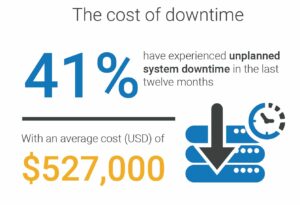Natural disaster, cyber-attack, scheduled data center maintenance: What do these have in common? They all cause disruption.
Disruption occurs for a variety of reasons, and whether planned or unplanned, you need a strategy. Traditional Disaster Recovery (DR) approaches relied on an all-or-nothing attitude when a disruption occurred, with the limited ability to only recover the full site, not specific applications or application bundlers. With the increasing number of applications managed by IT and the increasing reliance on those applications by business users, it’s time to consider your strategy.

The Dell Global Data Protection Index is a Dell commissioned survey of 2,200 IT decision makers across 18 countries globally on the maturity of their data protection strategies and how they value data and assess the relative preparedness of their businesses.
This year’s results paint a grim picture for those responsible for application availability, with over three quarters (76 percent) of respondents experiencing a disruption of some kind in the last 12 months. That’s 24 percent higher than the 52 percent who experienced an outage in the 2016 edition of the Global Data Protection Index1. 24%!!! This points toward a staggering trend of drastically increasing numbers of outages per year.
Breaking down the overall disruptions within this year’s report, there were a few key take away’s I wanted to highlight:
 With outages being so widespread and costly, early adopters have started looking toward the next generation of methods to maximize availability for their users. In fact, 41 percent of respondents had experienced unplanned system downtime in the last year, costing businesses an average of $527,000. To combat these costly disruptions, a recent concept has emerged as a favorite of early adopters – application mobility. This methodology minimizes both planned and unplanned downtime by ensuring either applications can quickly move between data centers, introducing true mobility. This could be executed to mitigate longer planned downtime or to recover from an isolated incident within the production data center, thus avoiding a longer outage or the need to failover to DR. One of the most critical steps in enabling application mobility is deeply analyzing your applications and their business requirements to better understand their use. Then, using this information, assigning an appropriate level of availability to each application or bundle. We’ll talk more about application mobility in future blog posts.
With outages being so widespread and costly, early adopters have started looking toward the next generation of methods to maximize availability for their users. In fact, 41 percent of respondents had experienced unplanned system downtime in the last year, costing businesses an average of $527,000. To combat these costly disruptions, a recent concept has emerged as a favorite of early adopters – application mobility. This methodology minimizes both planned and unplanned downtime by ensuring either applications can quickly move between data centers, introducing true mobility. This could be executed to mitigate longer planned downtime or to recover from an isolated incident within the production data center, thus avoiding a longer outage or the need to failover to DR. One of the most critical steps in enabling application mobility is deeply analyzing your applications and their business requirements to better understand their use. Then, using this information, assigning an appropriate level of availability to each application or bundle. We’ll talk more about application mobility in future blog posts.- Localized disasters happen. If a storm brought down power to your production data center, you would be part of the 25 percent of respondents who indicated that they experienced a disruption as a result. When these situations occur, it’s all-hands-on-deck to get back online. But now is the time to ask yourself, are you confident in your ability to failover to a DR site in the event of a disruption? Ensuring a well-designed and tested plan is in place before the disaster occurs has saved companies from millions in losses. In 2012, Hurricane Sandy tested the DR plans of those who had them while companies without them were offline. The next disaster in your area may not be a hurricane, but having a plan in place for full-site recovery is a key component of a holistic strategy to minimize disruption.
- As I’ve previously written about, having a cyber recovery strategy in place to reduce downtime and recover critical data in the event of a cyber-attack is essential. The drastically increasing threat landscape due to more applications, increased reliance on applications, and more connected devices has forced organizations to develop and thoroughly test their strategies. In the last few years, ransomware has been one of the most destructive and newsworthy variants of cyber-attacks, locking files and demanding ransom in return. Respondents to this year’s report noted this trend, indicating that nearly 30 percent had experienced an outage due to a ransomware attack. These attacks can be difficult to recover from and require specialized planning and technology to keep critical data isolated and ready for recovery.
These data points indicate a strong trend of both an increasing number of disruptions and causes of these disruptions. This trend, along with others, are also highlighted in “Keeping up with the Data Deluge: Exploring the Global Data Protection Index“.
A holistic, modern approach to mitigating disruption must take an application-centric view to minimize downtime, based on the criticality of each application to business stakeholders. All of the necessary considerations you should make when designing your plan to mitigate disruption are topics covered by the ProConsult Advisory Service for Business Resiliency.
If you have any comments or question, feel free to comment below.
1 https://www.emc.com/microsites/emc-global-data-protection-index/index.htm#infographic-global
Discover Dell Technologies’ vision for the future and learn new capabilities, how to reinvent processes, innovate faster and create value that will change the game for your business & career. Register for Dell Technologies World today.


